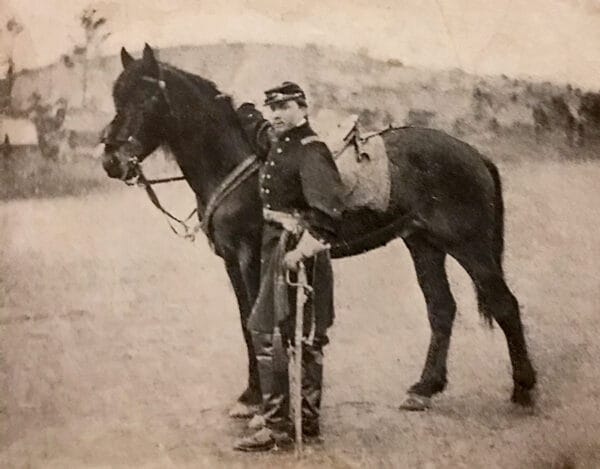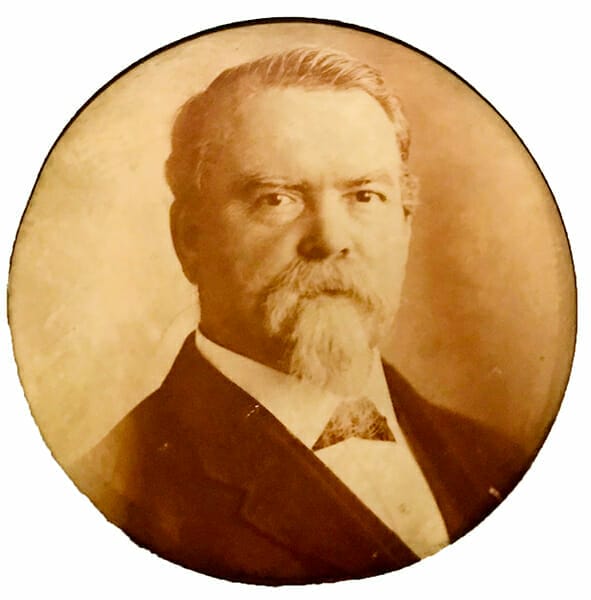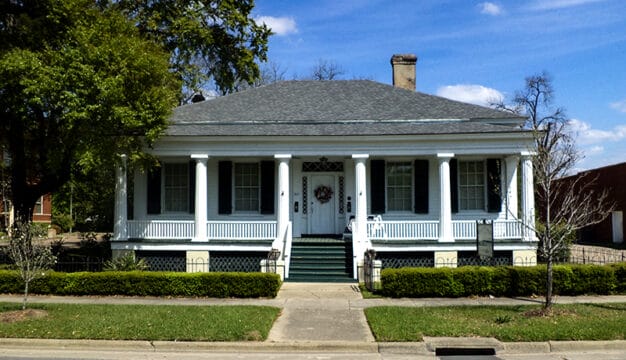Frank P. O'Brien
 Frank P. O’Brien
Frank (sometimes Francis) Patrick O’Brien (1844-1910) was an Irish immigrant who became a state representative, city mayor, alderman, sheriff, real-estate developer, newspaper-owner and editor, fresco painter, entrepreneur, and pioneer in the early days of Birmingham, Jefferson County. He served in the Confederate States Army, with the Montgomery True Blues, mostly in eastern North Carolina.
Frank P. O’Brien
Frank (sometimes Francis) Patrick O’Brien (1844-1910) was an Irish immigrant who became a state representative, city mayor, alderman, sheriff, real-estate developer, newspaper-owner and editor, fresco painter, entrepreneur, and pioneer in the early days of Birmingham, Jefferson County. He served in the Confederate States Army, with the Montgomery True Blues, mostly in eastern North Carolina.
O’Brien was born in Dublin, Ireland, on February 29, 1844, to Michael Andrew O’Brien and Mary Ellen Cochran. The couple had at least seven children. Michael had studied to be a priest, taught school, and had also worked for the Nation, a nationalist Irish newspaper based in Dublin. In 1848, when Frank was four, his family joined the 2.1 million Irish who fled Ireland between 1845 and 1855 to escape the disease and hunger caused by the Irish Potato Famine, which killed one-eighth of the Irish population.
The O’Brien family first settled in Honesdale, Pennsylvania, but soon moved to Scranton, where a large number of Irish immigrants had settled. In Scranton, most Irish immigrants took jobs as coal miners or railroad workers, and they worked with other men from their own counties back in Ireland in groups known as Corkonians, Far-Downs, Far-Ups, Connaught Men, and others who competed with each other for work. The groups’ natural dislike for each other was brought with them from Ireland, and it exploded in May 1850 into a battle between the Connaughts and the Far-Downs that would become known as the Irish War of 1850. Six-year-old Frank was an eyewitness, as he and his father had accidentally stumbled onto the battlefield on their way home from a business meeting.
 Frank O’Brien during the Civil War
At the age of 14, believing that he had been punished unfairly by his father for an unrecorded misdeed, O’Brien ran away from home. In Philadelphia, he met fresco painter Peter Schmidt, and as his apprentice O’Brien traveled the country helping Schmidt in his work. In 1859, this job brought him to Alabama, where Schmidt had been hired to paint the Montgomery Theater in Montgomery, Montgomery County, on North Perry Street. In 1861, at the outbreak of the Civil War, Frank joined the Independent Rifles in Pensacola, Florida, but shortly afterwards enlisted with the Montgomery True Blues (in the Third Alabama Infantry Regiment) and remained with this unit until the end of the war. The Third was the first Alabama regiment to enter Virginia and was stationed in Norfolk for about a year; it was then reorganized and the Montgomery True Blues were sent to eastern North Carolina. At some point, O’Brien would lead a unit of mounted scouts. He was wounded in two battles, Little Washington (a draw in spring 1863) and Plymouth, though it is unclear whether in the spring or fall battles of 1864. He was reportedly taken prisoner in December 1864 and paroled the following February, rejoining his unit until May when he was again paroled at the end of the war.
Frank O’Brien during the Civil War
At the age of 14, believing that he had been punished unfairly by his father for an unrecorded misdeed, O’Brien ran away from home. In Philadelphia, he met fresco painter Peter Schmidt, and as his apprentice O’Brien traveled the country helping Schmidt in his work. In 1859, this job brought him to Alabama, where Schmidt had been hired to paint the Montgomery Theater in Montgomery, Montgomery County, on North Perry Street. In 1861, at the outbreak of the Civil War, Frank joined the Independent Rifles in Pensacola, Florida, but shortly afterwards enlisted with the Montgomery True Blues (in the Third Alabama Infantry Regiment) and remained with this unit until the end of the war. The Third was the first Alabama regiment to enter Virginia and was stationed in Norfolk for about a year; it was then reorganized and the Montgomery True Blues were sent to eastern North Carolina. At some point, O’Brien would lead a unit of mounted scouts. He was wounded in two battles, Little Washington (a draw in spring 1863) and Plymouth, though it is unclear whether in the spring or fall battles of 1864. He was reportedly taken prisoner in December 1864 and paroled the following February, rejoining his unit until May when he was again paroled at the end of the war.
After the Civil War, O’Brien married Indiana (Dannie) McBride on October 11, 1865, and the couple had five children, including celebrated novelist Margaret O’Brien Davis, and Julia “Bossie” O’Brien Hundley Baer, one of Alabama’s leading suffragists. O’Brien moved his family to Birmingham in 1871, the same year the city was founded. This was a promising era for the young city, and the population swelled from 1,200 in 1871 to 4,000 in 1873. In that year, Birmingham suffered through a cholera epidemic that killed 128 citizens. The subsequent exodus drained the once-booming population, though the O’Brien family remained. O’Brien cared for those affected until he too was struck with the disease. He became so ill that a casket was ordered for him, but he eventually recovered and was remembered for this act of generosity throughout his life.
O’Brien was one of those rare individuals who had the combination of skill, luck, and vision, and in Birmingham, he was at the forefront local politics, industry, and entertainment. He was on the first board of aldermen. He brought the first steam machinery for making bricks and built the first rolling mill and the first coke ovens for the Pratt Coal and Iron Company. In 1872, he built Birmingham’s first entertainment venue, Sublett Hall, and even painted the scenery himself. Ignoring the nay-sayers who thought he had gone mad, O’Brien built the Birmingham Opera House in 1882 in what was then the middle of a cornfield. Not content with theater and industry, he was also the owner and editor of the Age Herald. When telephone service came to Birmingham in 1882, O’Brien was one of the first 39 subscribers, with phone lines installed at his home, his opera house, and his lumberyard. He was one of the charter members of the Elks Lodge in 1888. When the Birmingham Public Library opened in 1909, he was the first to fill out a library card and the first to check out a book.
 Frank O’Brien
In addition to a full business and social life, O’Brien was also very active in politics. He was elected to the Alabama House of Representatives in 1892 and served two terms. He was elected sheriff of Jefferson County in 1896 and mayor of Birmingham on May 8, 1909. In the spring of 1910, large areas of land were annexed to Birmingham, which made him the first mayor of Greater Birmingham. The demands of budgeting and managing such a large territory, in addition to a small-pox scare and racial tensions, proved to be very stressful for O’Brien and left him with a severe case of insomnia. On July 7, 1910, he left his office and worked from home, but the insomnia would not subside, and he developed a condition that doctors of the era referred to as “melancholia” and was likely what modern psychiatry would call “depression.”
Frank O’Brien
In addition to a full business and social life, O’Brien was also very active in politics. He was elected to the Alabama House of Representatives in 1892 and served two terms. He was elected sheriff of Jefferson County in 1896 and mayor of Birmingham on May 8, 1909. In the spring of 1910, large areas of land were annexed to Birmingham, which made him the first mayor of Greater Birmingham. The demands of budgeting and managing such a large territory, in addition to a small-pox scare and racial tensions, proved to be very stressful for O’Brien and left him with a severe case of insomnia. On July 7, 1910, he left his office and worked from home, but the insomnia would not subside, and he developed a condition that doctors of the era referred to as “melancholia” and was likely what modern psychiatry would call “depression.”
On August 13, O’Brien was admitted to Burn-Brae Sanitarium in Clifton Heights, a suburb of Philadelphia, which was about two hours away from his childhood home in Scranton. Although it initially appeared as though the mayor improved and might make a full recovery, he died, likely of a stroke, on September 9, 1910. He was buried in Birmingham’s Oak Hill Cemetery.



